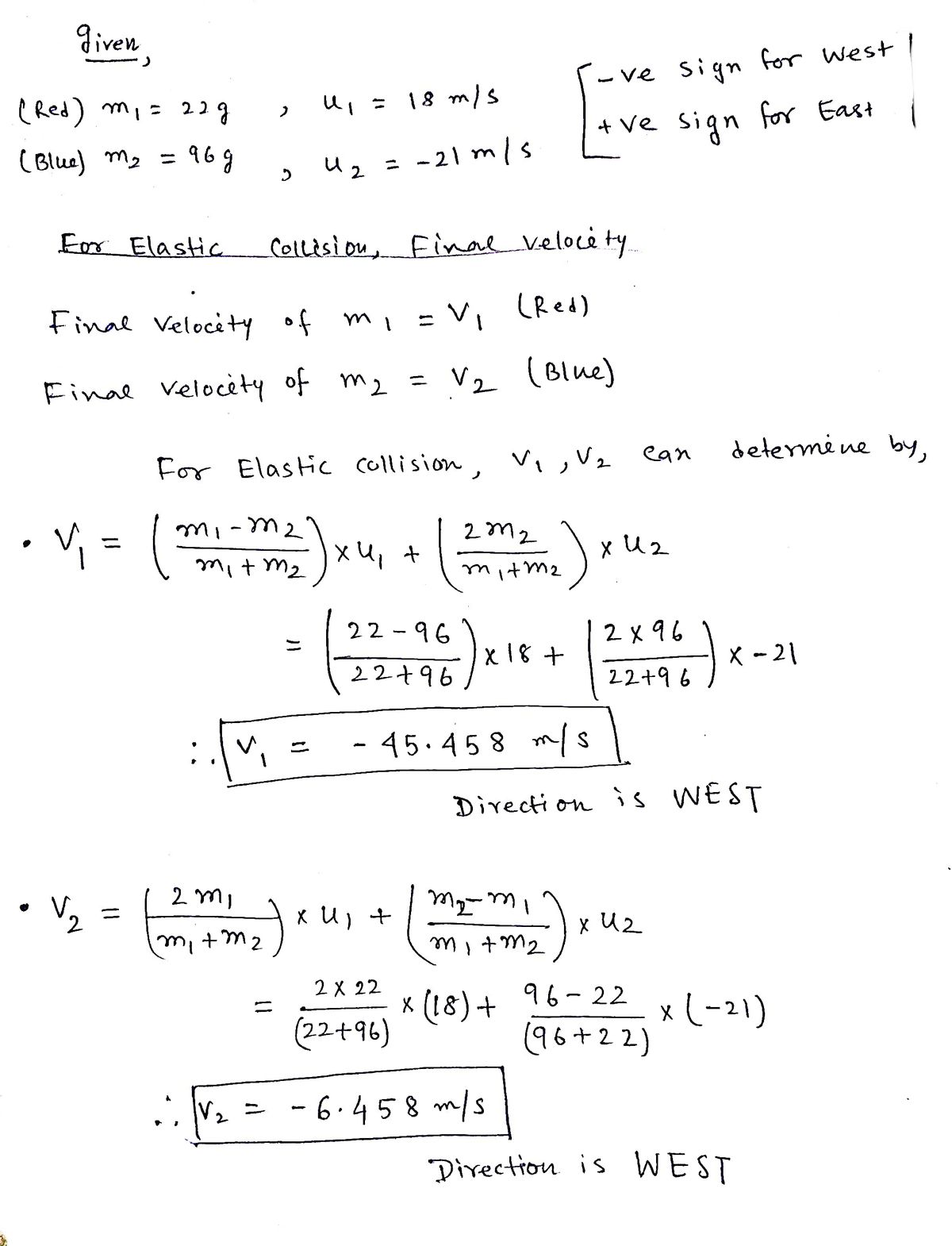A 22 g red superball traveling 18 m/s EAST has an elastic collision with a 96 g blue superball traveling 21 m/s WEST. Find the final speeds and directions of the superballs. Also determine how much thermal energy was generated during the collision. Submit Answer Red final speed. Blue final speed= Enter a number with units. direction = --Select- V ---Select-- ATE=
A 22 g red superball traveling 18 m/s EAST has an elastic collision with a 96 g blue superball traveling 21 m/s WEST. Find the final speeds and directions of the superballs. Also determine how much thermal energy was generated during the collision. Submit Answer Red final speed. Blue final speed= Enter a number with units. direction = --Select- V ---Select-- ATE=
College Physics
11th Edition
ISBN:9781305952300
Author:Raymond A. Serway, Chris Vuille
Publisher:Raymond A. Serway, Chris Vuille
Chapter1: Units, Trigonometry. And Vectors
Section: Chapter Questions
Problem 1CQ: Estimate the order of magnitude of the length, in meters, of each of the following; (a) a mouse, (b)...
Related questions
Question
Need help solving this problem.
![A 22 g red superball traveling 18 m/s EAST has an elastic collision with a 96 g blue superball traveling 21 m/s WEST. Find the final speeds and directions of the superballs. Also determine how much thermal energy was generated during the collision.
Red:
- final speed = [input box]
- direction = [dropdown menu]
Blue:
- final speed = [input box]
- direction = [dropdown menu]
ΔTE = [input box]
[Submit Answer] button
The section includes input fields for entering the final speeds and selecting the directions for the red and blue superballs. Additionally, there is a field to input the change in thermal energy (ΔTE) generated during the collision. Users can submit their answers using the "Submit Answer" button.](/v2/_next/image?url=https%3A%2F%2Fcontent.bartleby.com%2Fqna-images%2Fquestion%2F946aa72e-7881-4017-a582-113ad469f308%2F3e3a28fc-d179-44fc-939d-a745c13358ba%2Fcxe5fe_processed.jpeg&w=3840&q=75)
Transcribed Image Text:A 22 g red superball traveling 18 m/s EAST has an elastic collision with a 96 g blue superball traveling 21 m/s WEST. Find the final speeds and directions of the superballs. Also determine how much thermal energy was generated during the collision.
Red:
- final speed = [input box]
- direction = [dropdown menu]
Blue:
- final speed = [input box]
- direction = [dropdown menu]
ΔTE = [input box]
[Submit Answer] button
The section includes input fields for entering the final speeds and selecting the directions for the red and blue superballs. Additionally, there is a field to input the change in thermal energy (ΔTE) generated during the collision. Users can submit their answers using the "Submit Answer" button.
Expert Solution
Step 1

Step by step
Solved in 2 steps with 2 images

Knowledge Booster
Learn more about
Need a deep-dive on the concept behind this application? Look no further. Learn more about this topic, physics and related others by exploring similar questions and additional content below.Recommended textbooks for you

College Physics
Physics
ISBN:
9781305952300
Author:
Raymond A. Serway, Chris Vuille
Publisher:
Cengage Learning

University Physics (14th Edition)
Physics
ISBN:
9780133969290
Author:
Hugh D. Young, Roger A. Freedman
Publisher:
PEARSON

Introduction To Quantum Mechanics
Physics
ISBN:
9781107189638
Author:
Griffiths, David J., Schroeter, Darrell F.
Publisher:
Cambridge University Press

College Physics
Physics
ISBN:
9781305952300
Author:
Raymond A. Serway, Chris Vuille
Publisher:
Cengage Learning

University Physics (14th Edition)
Physics
ISBN:
9780133969290
Author:
Hugh D. Young, Roger A. Freedman
Publisher:
PEARSON

Introduction To Quantum Mechanics
Physics
ISBN:
9781107189638
Author:
Griffiths, David J., Schroeter, Darrell F.
Publisher:
Cambridge University Press

Physics for Scientists and Engineers
Physics
ISBN:
9781337553278
Author:
Raymond A. Serway, John W. Jewett
Publisher:
Cengage Learning

Lecture- Tutorials for Introductory Astronomy
Physics
ISBN:
9780321820464
Author:
Edward E. Prather, Tim P. Slater, Jeff P. Adams, Gina Brissenden
Publisher:
Addison-Wesley

College Physics: A Strategic Approach (4th Editio…
Physics
ISBN:
9780134609034
Author:
Randall D. Knight (Professor Emeritus), Brian Jones, Stuart Field
Publisher:
PEARSON